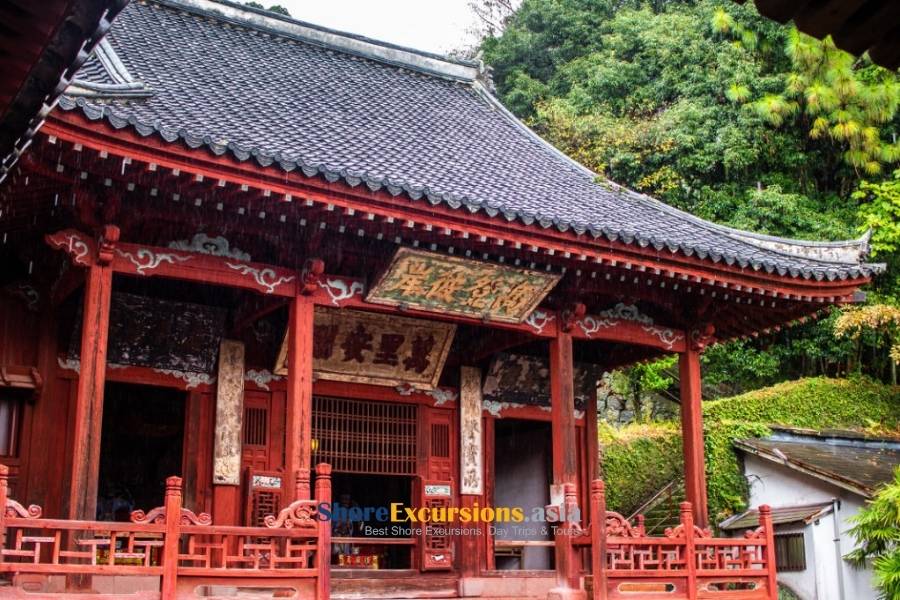Tucked away in the cultural mosaic of Nagasaki, Sofukuji Temple is a hidden treasure that transports visitors beyond Japan’s borders and into the soul of ancient China. As one of the most captivating stops on many Nagasaki shore excursions, this centuries-old temple offers a rare blend of tranquility, history, and architectural splendor. Just minutes from the cruise port, it invites cruise travelers to step into a peaceful world shaped by devotion, heritage, and timeless beauty.
Overview about Sofukuji Temple in Nagasaki
Nagasaki shore excursions deliver visitors to not only Peace Memorial Park, although this attraction can’t be excluded, but also many other beautiful sights. Constructed in 1629 for Nagasaki's Chinese residents according to contemporary Chinese architecture, Sofukuji Temple looks like a Chinese temple rather than a Japanese temple. Especially, the temple ranks among the best temples with Ming Dynasty architecture style, even more featured than some in China.
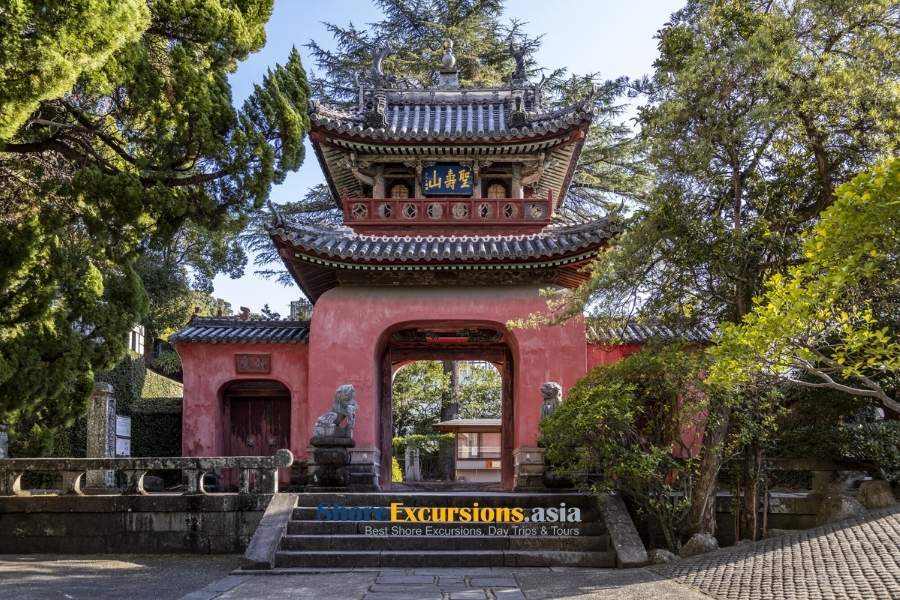
Thanks to being heavily influenced by Chinese architecture style, Sofukuji Temple belongs to Obaku, along with Rinzai and Soto as the three Zen sects in Japan. The reason for its architecture is starting from the temple’ origin when the Japanese government allowed Chinese residents to build sites for practicing their religion. Moreover, their priests and monks could also live in Nagasaki. In 1629, a Chinese monk Chaonian finally founded Sofukuju Temple for Chinese residents.
History and Cultural Significance of Sofukuji Temple
Sofukuji Temple was originally built by Chinese monks from the Fujian province to serve the spiritual needs of Nagasaki’s Chinese community during the Edo period. This temple not only functioned as a religious center but also symbolized the deep commercial and cultural ties between Nagasaki and China. Over centuries, Sofukuji has preserved its heritage, surviving wars and modernization, and remains a vital cultural landmark reflecting the fusion of Japanese and Chinese traditions.
Architectural Highlights of Sofukuji Temple
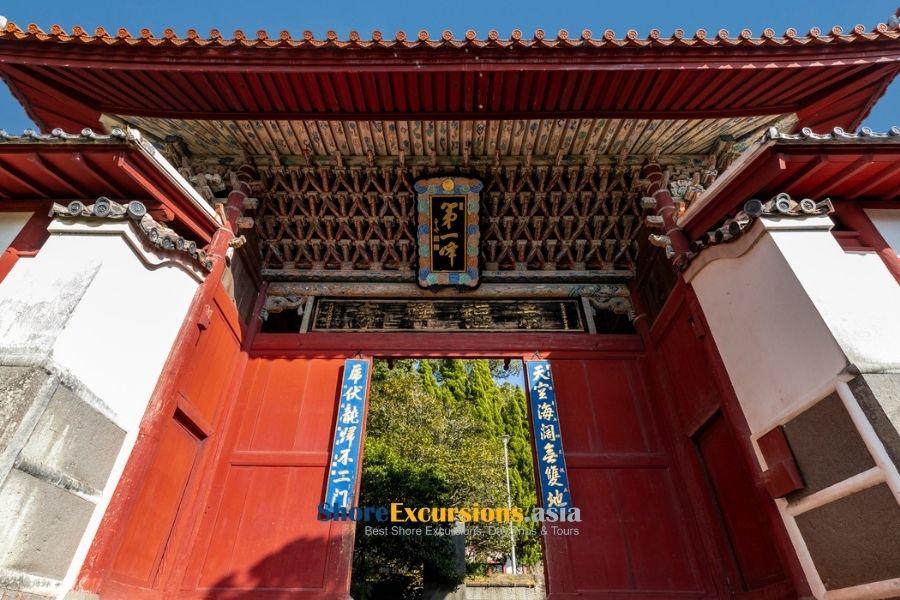
One of the most striking features of Sofukuji Temple is its architecture, which distinctly contrasts with typical Japanese temples. The temple’s entrance, known as Ryugumon or the Dragon Gate, is a two-story red gate built in 1673. This vibrant gate welcomes visitors with its intricate carvings and traditional Chinese design.
Inside the temple grounds, the Buddha Hall (Daibutsuden) stands out as a centerpiece. Imported from China and assembled at Sofukuji in 1646, it is one of Nagasaki’s oldest wooden structures. The hall houses exquisite Buddha statues and ancient bronze bells dating back to the 17th century. Other notable structures include the Daioomon and Daieiden halls, all featuring curved roofs, red walls, and detailed ornamental work that reflect classic Chinese aesthetics.
Top Best Experiences to Enjoy at Sofukuji Temple
Visiting Sofukuji Temple Nagasaki is more than just a sightseeing stop. It’s a cultural journey filled with memorable experiences that showcase the unique blend of Chinese and Japanese heritage in the region.
Walk Through the Ryugumon Gate and Admire Chinese-Inspired Architecture
Your journey begins at the Ryugumon Gate, an impressive red-lacquered entrance that instantly sets Sofukuji apart from typical Japanese temples. This dragon-shaped gate is a striking example of Ming dynasty architecture, with curved eaves, vibrant colors, and intricate wooden carvings. Walking beneath its arches, visitors often feel as if they’ve stepped into a different country, a rare and fascinating experience in Japan.
Explore Sacred Halls, Buddha Statues, and Historical Artifacts
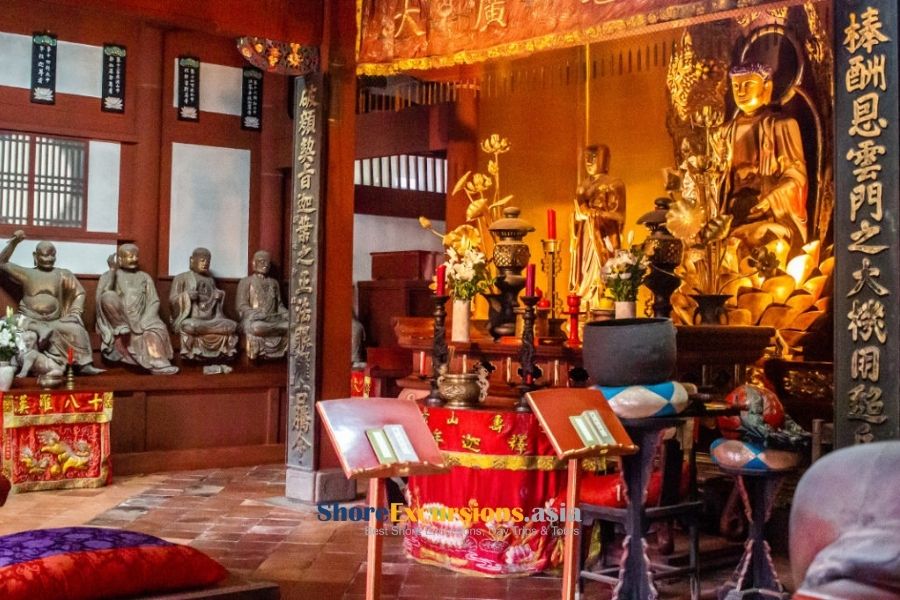
Inside the temple grounds, you’ll discover beautifully preserved worship halls, each housing significant Buddha statues and ancient religious relics. The Daiyuhoden Main Hall is particularly noteworthy for its majestic representation of Shakyamuni Buddha and elaborate woodwork. Every corner tells a story, from imported tiles to calligraphy panels donated by Chinese monks and merchants centuries ago.
Learn About Traditional Rituals and Local Festivals
Sofukuji Temple remains an active spiritual site, offering visitors a glimpse into traditional Zen rituals. If you visit during late summer, you may witness its involvement in one of the famous festivals in Japan - the Nagasaki Lantern Festival. This is a spectacular event that lights up the city with thousands of glowing lanterns, cultural performances, and temple ceremonies. It’s a beautiful opportunity to see how this temple continues to be a living part of Nagasaki’s community life.
Join a Half-Day Walking Tour with Nearby Highlights

For cruise passengers or short-stay visitors, a half-day walking tour is a perfect way to explore Sofukuji Temple and nearby cultural gems. The well-paced tours are ideal for travelers seeking authentic experiences, historical insights, and leisurely exploration, all within easy reach from the Nagasaki cruise port. These often include stops at:
Kofukuji Temple – Another historically significant Chinese-style temple
Spectacles Bridge (Meganebashi) – One of Nagasaki’s most iconic stone bridges, shaped like a pair of glasses
Hamanomachi Shopping Street – A lively area filled with local shops, street food, and souvenirs
Practical Tips for Visiting Sofukuji Temple
Planning your visit to Sofukuji Temple Nagasaki is easy, especially for cruise passengers looking for a convenient and rewarding cultural experience. Here’s everything you need to know to make the most of your trip:
How to Get There from Nagasaki Cruise Port
Sofukuji Temple is conveniently located about 10 to 15 minutes by car from the Nagasaki cruise port, making it an ideal stop on half-day or private tours. Here are your main transport options:
Taxi: Readily available at the cruise terminal. A one-way ride costs approximately ¥1,200–¥1,500.
Shuttle Bus: Often arranged by cruise lines or tour operators. Inquire in advance.
Streetcar (Tram): Take Tram Line 1 or 5 to Shokakuji-shita Station. From there, it’s a short 5–10-minute walk uphill to the temple. This is the most economical and local-friendly option.
For cruise guests on guided tours, transportation is usually included, along with commentary on the sights en route.
Accessibility Information for Visitors
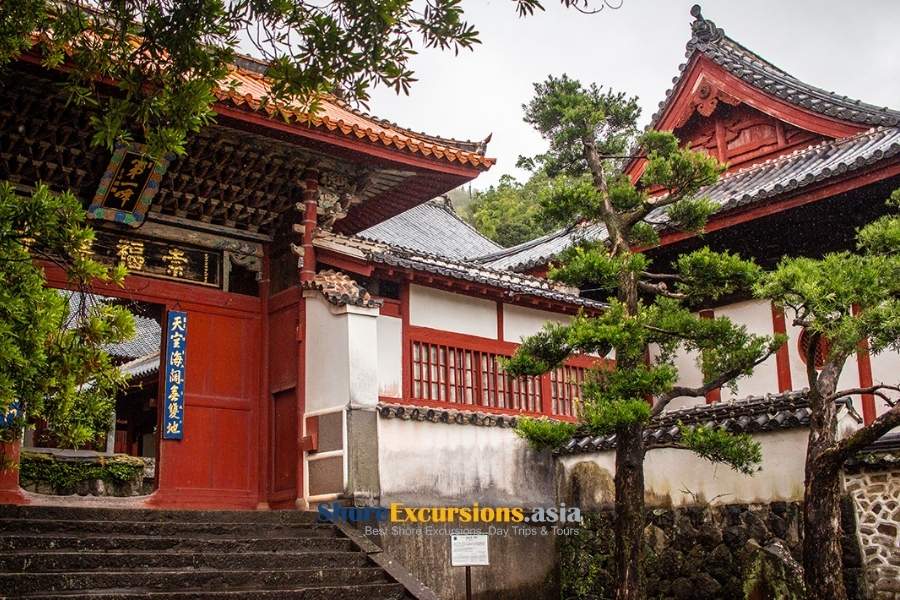
Sofukuji Temple’s grounds are thoughtfully maintained, yet due to its historical architecture and natural terrain, some areas may present challenges for visitors with limited mobility. While most parts of the temple complex are accessible, expect to encounter:
Stone steps and uneven pathways: Several sections feature traditional stone stairs and gently sloped walkways that may be difficult to navigate for those using wheelchairs, walkers, or with mobility impairments.
Narrow corridors and thresholds: Some temple buildings have low doorways and narrow passages typical of 17th-century construction.
For travelers requiring extra assistance, private tours in Nagasaki are highly recommended. These tours often provide personalized support, including accessible transport options and guides who can tailor the route to your needs, ensuring you don’t miss the temple’s key highlights. If you or someone in your party has limited mobility, contacting tour operators ahead of time will help arrange a comfortable, stress-free visit.
Essential Items to Bring for Your Visit to Sofukuji Temple
Preparing for your visit to Sofukuji Temple ensures comfort and convenience throughout your exploration:
Comfortable walking shoes: Expect to walk on a mix of stone paths, stairs, and occasional uneven terrain, so sturdy, slip-resistant footwear is a must.
Water and sun protection: Nagasaki’s climate can be warm and humid, especially from late spring through early autumn. Carry bottled water, sunscreen, and a hat or sunglasses to stay hydrated and protected.
Camera or smartphone: The temple’s vibrant red gates, intricate carvings, and peaceful gardens provide excellent photography opportunities. Don’t forget extra memory cards or batteries!
Small cash in Japanese yen: Entrance fees are modest but usually cash-only. You may also want some yen for small offerings, souvenirs, or nearby refreshments. ATMs are not always available close to the temple.
Light jacket or shawl: If you visit during cooler months or the early morning, temperatures can be chilly, so layering is advisable.
Respectful Behavior and Cultural Etiquette at Sofukuji Temple
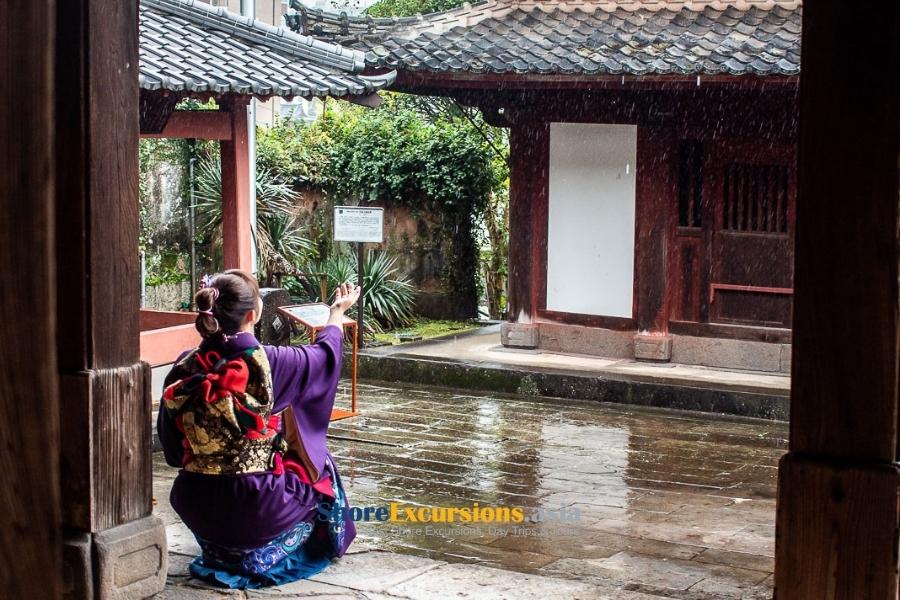
As a sacred site with a living religious community, Sofukuji Temple invites visitors to observe local customs and show respect:
Maintain a quiet and calm demeanor: Keep conversations low and avoid loud noises to preserve the temple’s tranquil atmosphere.
Photography rules: Taking photos is generally permitted in outdoor areas and some halls, but refrain from using flash inside worship halls or near statues to protect delicate artworks and respect worshippers.
Remove hats and avoid distractions: When entering prayer halls or participating in rituals, remove hats and avoid disruptive behavior.
Observe incense and offerings respectfully: If you see incense burning or offerings placed on altars, watch quietly without touching or disturbing them. These are sacred acts of devotion.
Follow posted signs and guidelines: Pay attention to any specific instructions or restrictions to ensure your visit is both enjoyable and culturally appropriate.
Dispose of trash properly: Carry any litter with you or dispose of it in designated bins to help keep the temple grounds pristine.
Visitor Information and Tips
Before stepping into the serene grounds of Sofukuji Temple, it’s helpful to know a few practical details to ensure a smooth and enjoyable visit. Whether you're arriving as part of a Nagasaki shore excursion or exploring independently from the Nagasaki cruise port, this guide covers essential information, so you can make the most of your time at one of Nagasaki’s most culturally rich landmarks.
Opening Hours: 8:00 AM – 5:00 PM daily
Admission Fee: Approximately ¥300 (subject to change)
Getting There: Taxis and shuttle buses are readily available at the cruise terminal. Local trams also provide easy access to the temple area.
Pro Tip: Visit early in the morning for fewer crowds and to enjoy the temple's tranquil setting fully.
In conclusion, whether you're a history lover, a photography enthusiast, or simply looking to enrich your Nagasaki shore excursion, Sofukuji Temple offers a refreshing, culturally immersive experience. From its striking architecture to its historical depth, this temple is more than just a sightseeing stop, it's a journey into Japan’s international roots. Book your tour today on Japan Shore Excursions and make your Nagasaki visit truly unforgettable.

